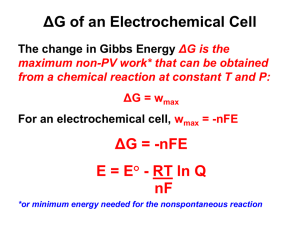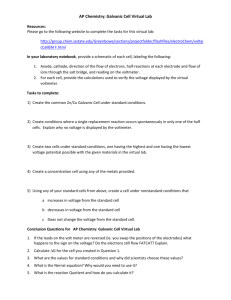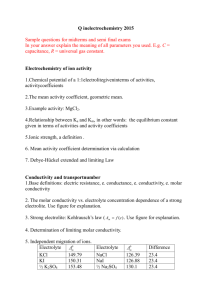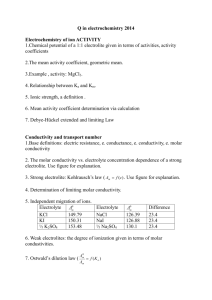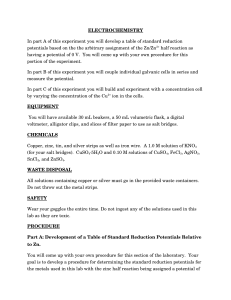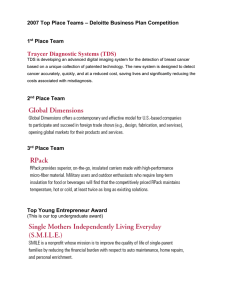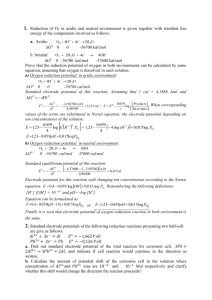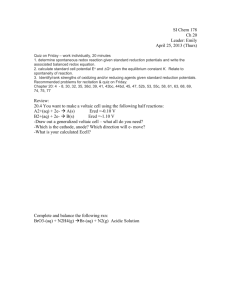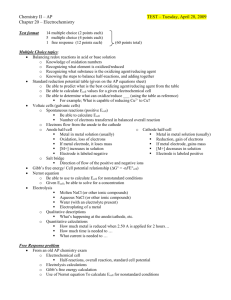Document 12342592
advertisement
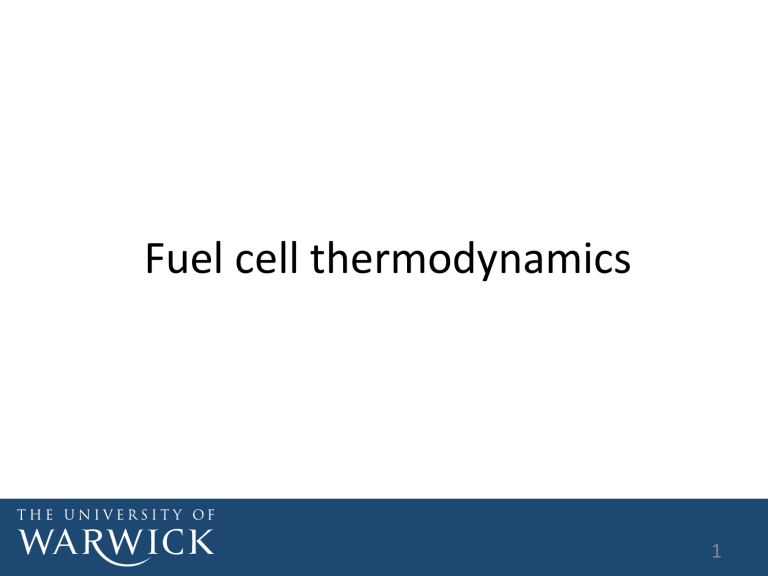
Fuel cell thermodynamics 1 Overview • • • • • • • • • • First law applied to electrochemical cells Fuel cell reac5ons EMF and work Reversibility (second law) and Gibb’s free energy Chemical poten5al Link between Gibb’s and par5al pressure Link between chemical poten5al and par5al pressure Nernst equa5on and Nernst equilibrium Ac5vity and Nernst equilibrium in the general case Quiz 2 First Law • • • • • dU = δQ − δW (1st Law) ∆U = ∆Q − ∆W (1) dU is the system (internal) energy δQ and δW -­‐ heat input into system and work done by the system respec5vely An open system allows both mass and energy transfers while a closed system allows only energy transfer Isolated system and isolated system allows neither mass nor energy transfer through its boundaries A fuel cell is an open system (mass flows in and out of a fuel cell) in which work is obtained from the flow of electrons (as opposed to mechanical mo5on) in the form of electricity 3 First Law • For an open system: increase in energy within the system = (change in internal energy) + (work entering system) + (energy entering system with mass flowing in) − (energy leaving system with mass flowing out) dE = dU + dKE + dPE + d(PV) (2) o dU – change in internal energy of the system o dKE, dPE – changes in kine5c & poten5al energies o d(PV) – change in pressure-­‐volume work 4 First Law • Enthalpy (H) is a measure of total system energy (internal energy + PV work) H = U + PV (3) • Combine with (1) and (2) and assume steady flow with negligible changes in KE and PE dH = δQ − δW 5 Fuel cell reac5ons • • • • • • Overall: Fuel + oxidant = products e.g. H2 + (1/2)O2 à H2O This is an electrochemical reac5on Reac5on involves charge transfer (of electrons) between two half cells The transfer of 6.023 x 1023 (1 mole) electrons is equivalent to 6.023 x 1023 × e (e = 1.6 x 10–19 C) Coulombs = 96486 Coloumbs = Faraday’s constant (F) –charge carried by 1 mole of electrons The genera5on of this charge and the flow of this charge will lead to a current Current is charge passed per unit 5me Current [Amps] = Charge [C] /5me [s] 6 EMF and work • For n moles of electrons transferred (depends on the stoichiometry of the reac5on), the charge transfer is nF • For a H2 /O2 fuel cell n = 2 mol electrons per mol of H2 or n = 4 per mol of O2 . We have to be consistent when we look at individual electrode reac5ons • Electrical work done by the fuel cell δW is nFEcell, where Ecell is the cell voltage or electromo5ve force (EMF) (work done by system > 0) Ecell = Ecathode − Eanode • Ogen the defini5on Ecell = Ereduction − Eoxidation is used • In a baiery the anode (oxida5on) and cathode (reduc5on) swap from charge to discharge, whereas Ecell is always defined as > 0 in a baiery by conven5on. Therefore it is beier to use the defini5on Ecell = E+ve − E-ve • Once a load is connected to the circuit current will be drawn • If no other work is done, e.g., PV work, for an infinitesimal charge transfer dq = Fdn across a poten5al difference Ecell dH = δQ − δW = δQ − FEcell dn (4) 7 EMF and work • EMF measured in Volts (V) • Significance of 1 Volt: 1 Joule of energy is available when 1 C of charge is transferred (or moves between) a potenAal difference of 1 V • 1 Volt = 1 Joule/Coulomb • So the EMF is the electrical energy available from the system (cell) per unit charge that is transferred between the electrodes • If all of this energy is converted to electrical work, it would be the maximum electrical work available due to the poten5al difference between the electrodes • Unfortunately, the poten5al difference between the electrodes is not maintained at the theore5cal value (EMF/OCV) once we place a load on the cell and force a current flow. We will study this in detail later – for now we assume we have an ideal situa5on 8 Reversibility • For a reversible system δQ = TdS where S = entropy, and T = constant temperature (in general for an irreversible process dS >δQ/T) dH = δQ − FEcell dn = TdS − FEcell dn or dH − TdS = − FEcell dn =δW • If the cell is opera5ng reversibly the useful work obtained is maximal (no losses, e.g., fric5onal). • In this ideal case, electrical work done = Gibbs free energy change, dG = dH − TdS (strictly at constant T and P) dG = − δW = −FEcell dn (5) Or for finite changes in G and n: ΔG = − nFEcell 9 Reversibility • We have defined the Gibbs Free Energy: G = H − TS • Thermodynamically this is the maximum useful work obtainable from a system • H represents total energy of the system (expect KE and PE) • TS represents the “unavailable” energy – the losses that cannot be avoided due to irreversibili5es • G represents the energy available to do useful work (“free” ) • If ΔG < 0 a reac5on is spontaneous • From ΔG = − nFEcell this means Ecell > 0 10 Chemical poten5al • Need a version of 1st law with dependence on ni (number of moles of species i in the system): dU = δQ − δW = TdS −PdV +Σ µi dni (6) • µi is the chemical poten5al of species i • Defined as free energy contribuAon to the system per mole of species i entering or leaving the system (see later) • Independent of mass and path (intensive state quan5ty) 11 Chemical poten5al for ideal gas G = H − TS è dG = dH − TdS − SdT H = U + PV è dH = dU + PdV + VdP Therefore dG = dU + PdV + VdP − TdS − SdT (8) From (6) dU = TdS −PdV +Σ µi dni (9) 12 Rela5ng G and P Therefore dG = TdS −PdV +Σµidni + PdV + VdP − TdS − SdT = Σµidni + VdP − SdT • At constant T and P dG = Σµidni = µ1dn1 + µ2dn2 +….. • In fact (Gibbs-­‐Duhem) G = Σµini ✓ ◆ @G µ j = @nj µi ,ni • From (9b) ✓ ◆ @G @P • For ideal gases V = nRT/P ✓ @G @P ◆ (9b) (10) (12) =V T,n T,n nRT = P (11) (13) 13 Rela5ng G and P and μ and P • Integra5ng (13) w.r.t. P G=G G0 = nRT ln ✓ P P0 ◆ against some reference standard state G0, P0 (STP) • For a species i in an ideal gas mixture ✓ ◆ Pi 0 Gi = Gi Gi = ni RT ln Pi0 • Pi is the par5al pressure of species i • Differen5ate w.r.t. ni and recall defini5on (11) ✓ ◆ • Pi 0 µi = µi + RT ln Pi0 • μi0 is the chemical poten5al at the reference (standard) state (14) (15) 14 Nernst equa5on • For a given reac5on, change in G is (from (10)) dG = Σµidni = µ1dn1 + µ2dn2 +…. • Consider a reac5on (15b) ν r ⇔ ν p r r p p H 2 + 12 O 2 → H 2O • r, p = product, reactant species; νi is a stoichiometric coefficient = number of moles of i reac5ng) ∑ ∑ 15 Nernst equa5on • Change in Gibb’s free energy is X X G= ⌫ i µi = ⌫ p µp p i X ⌫ r µr r (16) • νi is the number of moles of i involved in the reac5on (< 0 if a reactant and > 0 if a product) • In the second form, define both νr and νp as > 0 • For n moles of electrons transferred during reac5on (eq. (5)) ! ΔG = −nFEcell • Subs5tu5ng equa5on (15) into ✓equa5on ◆ (16) G= X p ⌫p µ0p X r ⌫r µ0r + RT ln Y Pp⌫p Pr⌫r = nF E cell nFE (17) 16 Nernst equa5on • For standard condi5ons (all Pi = 1), denoted by ‘0’ G= G0 = X p ⌫p µ0p X r ⌫r µ0r = nF E 0cell nFE (18) • Recall that this is how we defined E0: E0cell is EMF under standard condi5ons (of pressure and concentra5on with par5al pressures = 1) • It can be calculated from the E0 values of the individual electrodes as E0cathode– E0anode 17 Nernst equa5on • General rela5onship (eq. (17) & (18)) G= G0 + RT ln ✓Y ⌫ Pp p Pr⌫r ◆ = nFE nF E 0cell (19) • Which relates EMF to measureable quan55es and proper5es of the reactants • From eq. (19) ✓ ◆ 0 G RT + ln nF nF Y Pp⌫p Pr⌫r = EEcell • From (18) ΔG0 = −nFE0cell 18 Nernst equa5on • So 0 E0 Eeq = EE= cell RT ln nF ✓Y ⌫ Pp p Pr⌫r ◆ (20) • This is the Nernst equa5on (for the whole cell) • It applies to individual electrode reac5ons as well as the whole cell (for whole cell it is called open circuit voltage) • It defines the Nernst equilibrium: When the net current is zero, E = Eeq • This is only achieved when no current is drawn (no load is connected) from the cell, i.e., it is not asked to do any work • This is valid for ideal gases. For more general mixtures we need the reac5on quo5ent 19 Nernst equa5on: generalisa5on • • • To be more general, replace equa5on (14) with Gi = G0i + RT ln α aii α aii is the ac5vity of species i. The propensity for a given material to contribute to a reacAon • Ac5vity scales with concentra5on (liquid) or par5al pressure (gas) 0 0 α a = P/P αa = C/C • γ is ac5vity coefficient (close to 1 for dilute solu5ons and low par5al pressures) – usually ignored. Reference values usually 1. 20 Nernst equa5on: generalisa5on • Now replace equa5on (20) with G = G0 + RT ln Q ⌫ Yα apνp p Q= α a⌫rrν r • Q is the reac5on quo5ent • Ogen replace α’s with concentra5ons • The ac5vi5es of solids and water are taken to be 1 • Concentra5ons are in units of ‘Molar’: • 1 M = 1 mol L−1 = 1 mol dm−3 = 1000 mol m−3 • Using concentra5ons, equa5on (20) becomes p r 21 Nernst equa5on: Generaliza5on ν ⎛ ⎞ C RT p 0 Eeq = Ecell − ln ⎜ ∏ ν ⎟ nF ⎝ Cr ⎠ • Cp represents concentra5on of product p and Cr of reactant r • Applies to half cells (electrodes) as well as full cells • For an individual electrode reac5on it is applied in exactly the same way bearing in mind the reac.on is always wri4en as a reduc.on (important when we calculate ΔG), i.e, νOO +ne– à νRR: νR ⎛ ⎞ RT C 0 R Eeq = E − ln ⎜ νO ⎟ nF ⎝ CO ⎠ p r • For individual half cells ΔG0 = −nFE0 (the standard poten5al) • For the full cell Eeq gives the open circuit voltage (voltage or EMF for zero current) 22 Standard Reduc5on Poten5al Tables F2 + 2e– = 2F– +2.87 Co3+ + e– = Co2+ +1.81 Au+ + e– = Au Ce4+ + e– = Ce3+ 2H+ + 2e– = H2 0.0000 Pb2+ + 2e– = Pb -­‐0.13 +1.69 Sn2+ + 2e– = Sn -­‐0.14 +1.61 In3+ + 3e– = In -­‐0.34 Br2 + 2e– = 2Br– +1.09 Fe2+ + 2e– = Fe -­‐0.44 Ag+ + e– = Ag +0.80 Zn2+ + 2e– = Zn -­‐0.76 Fe3+ + e– = Fe2+ +0.77 V2+ + 2e– = V -­‐1.19 Cu2+ + 2e– = Cu +0.34 Cs+ + e– = Cs -­‐2.92 AgCl + e– = Ag + Cl– +0.22 Li+ + e– = Li -­‐3.05 Sn4+ + 2e– = Sn2+ +0.15 23 Example 1 For the following reac5on: Cu(s) + Zn2+(aq) ↔ Cu2+(aq) + Zn(s) 1. Calculate ΔG0 2. Is this reac5on spontaneous? 24 Example 1 • Free energy is related to cell EMF by the formula: ΔG0 = –nFE0cell • Break the redox reac5on into oxida5on and reduc5on half-­‐reac5ons. Cu → Cu2+ + 2 e– (oxida5on) Z2++ 2 e– → Zn (reduc5on) 25 Example 1 • From the Table of Standard Reduc5on Poten5als Cu → Cu2+ + 2 e– E0 = 0.3419 V Zn2+ + 2 e– → Zn E0 = –0.7618 V • Therefore • E0cell = Ecathode − Eanode • E0cell = –0.7618 V – 0.3419 V = –1.104 V 26 Example 1 • Find ΔG°. There are 2 moles of electrons transferred in the reac5on for every mole of reactant, therefore n=2 ΔG0 = –nFE0cell ΔG0 = – (2 mol)(9.648456 x 104 C/mol)(–1.104 J/C) ΔG0 = 213.04 kJ mol–1 • ΔG0 > 0 so the reac5on is not spontaneous (it is spontaneous in reverse) 27 Example 2 Consider the reac5ons Fe3+ + e– ⇔ Fe2+ E0 = 0.77 V Cu2+ + 2e– ⇔ Cu E0 = 0.34 V For which combina5on (anode/cathode) will we have a favourable overall reac5on? • Calculate the Gibb’s free energy change for each half reac5on • What is the resul5ng OCV under standard condi5ons? • Calculate the change in Gibb’s free energy using the cell voltage? • • • • 28 Example 2 • The reduc5on (occurs in a cathode) of Fe3+ is more favorable (higher E0). Keeping the Fe half-­‐reac5on as wriien, and reversing the Cu half-­‐reac5on we get the overall reac5on: 2Fe3+ + Cu ⇔ 2Fe2+ + Cu2+ • ΔG0cathode = −nFE0cathode = − 1F × 0.77 = −74.3 kJ /mol Fe3+ • ΔG0anode = −nFE0anode = − 2F × 0.34 = − 65.6 kJ /mol Cu3+ • Note that we calculate the total ΔG by adding the free energy changes of the individual reac5ons Occurs in reverse 2 for every 2 moles of electrons • ΔG0cell = (+ 65.6) + (2× −74.3) = 83 kJ 29 Example 2 • E0cell = 0.77 V – 0.34 V = 0.43 V > 0 (spontaneous reac5on) • ΔG0 = –nFE0cell = 2F × 0.43 = 83 kJ mol–1 Cu 30 Quiz 1. Consider the cell reac5on Cu2+(aq) + Zn(s) Zn2+(aq) + Cu(s) ⇔ • What are the half cell reac5ons and the standard poten5als • State which is the cathode and which is the anode reac5on • Calculate the standard OCV • If [Cu2+] = 2 M and [Zn2+] = 0.2 M, what is the cell voltage at 25 C? Note: You will need the Nernst equa.on ν ⎛ ⎞ RT C 0 R ln ⎜ ν ⎟ Eeq = E − nF ⎝ CO ⎠ 2. Explain why in a baiery the electrodes switch from cathode to anode or vice versa between charge and discharge R O 31 Quiz 3. Calculate the cell voltage for the following cell reac5on Fe(s) + Cu2+(aq) Fe2+(aq) + Cu(s) ⇔ where [Cu2+] = 0.3 M and [Fe2+] = 0.1 M • If [Cu2+] = 0.3 M, what [Fe2+] is needed so that Ecell = 0.76 V? First find the half cell reac5ons and corresponding E0 values, the cell OCV under standard condi5ons, then use Nernst equa5on for the cell and again for the second part] 32 f the electrochemical cell in Figure 11.8? Write the shorthand or the electrochemical cell. Quiz Ques5on 4 • Iden5fy the cathode and salt bridge anode reac5ons and KCl Chapter 11 Electrochemical write down the overall Metho reac5on for the cell on the lChapter eg 11 Electrochemical M + FeCl2 on of Ag to Ag is the left• half-cell. HCl occurs at the anode, which What is the cell voltage AgCl(s) Ag – Pt reaction is 3 solution contains a source of Cl , theFeCl anodic given the ac.vi.es (a) + − − shown in the figure? aAg –= ion of to occurs at the anode, which is the left half-cell. = 0.0100 aFee2+ Ag (0.100 s )Ag + Cl ( aq ) É AgCl (s ) + Cl ical 0.0500 reaction • What would be the he solution contains a source of Cl–,athe is Fe3+ =anodic 3+ c reaction, which is the right half-cell, is the reduction ofac5vity Fe of Fe3+ if the − − Ag( s ) + Cl ( aq ) É AgCl( s ) + e ac5vity of Cl– was 1.0, the 3+ − 2+ 3+ of Fe2+ was 0.015, ac5vity Fe ( aq ) + e É Fe ( aq ) dic reaction, which is the right half-cell, is the reduction of Fe and Ecell was + 0.546 V? potentiometer cell reaction, therefore, is 3+ − 2+ ( aq )−+ e É Fe ( aq ) 2+ 3+ Fe Ag( s ) + Fe ( aq ) + Cl ( aq ) É AgCl( s ) + Fe ( aq ) 33
